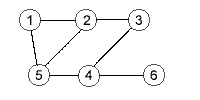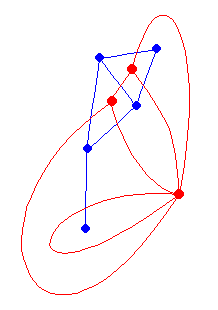Planar graph
|
|
In graph theory, a planar graph is a graph that can be embedded in a plane so that no edges intersect. For example, the following two graphs are planar:
 Missing image
Missing image
Complete_graph_K4.png
(the second one can be redrawn without intersecting edges by moving one of the diagonal edges to the outside),
while the two graphs shown below are not planar:
Complete_graph_K5.png
Complete_bipartite_graph_K3,3.png
It is not possible to redraw these without edge intersections. In fact, these two are the smallest non-planar graphs, a consequence of the characterization below.
| Contents |
Kuratowski's theorem
The Polish mathematician Kazimierz Kuratowski provided a characterization of planar graphs, now known as Kuratowski's theorem:
- A finite graph is planar if and only if it does not contain a subgraph that is an expansion of K5 (the complete graph on 5 vertices) or K3,3 (complete bipartite graph on six vertices, three of which connect to each of the other three).
An expansion of a graph results from inserting vertices into edges, i.e. changing an edge * --- * to * --- * --- *, and repeating this zero or more times. Equivalent formulations of this theorem, also known as "Theorem P" include
- A finite graph is planar if and only if it does not contain a subgraph that is homeomorphic to K5 or K3,3.
and
- A finite graph is planar if and only if it does not have K5 or K3,3 as a minor.
A far-reaching generalization of Kuratowski's theorem is given by the Robertson-Seymour theorem; in the language of this theorem, K5 and K3,3 are the "forbidden minors" for the class of finite planar graphs.
Other planarity criteria
In practice, it is difficult to use Kuratowski's criterion to quickly decide whether a given graph is planar. However, there exist fast algorithms for this problem: for a graph with n vertices, it is possible to determine in time O(n) whether the graph is planar or not. For a simple, connected, planar graph with n vertices and e edges:
- Theorem 1. If n ≥ 3 then e ≤ 3n - 6
- Theorem 2. If n > 3 and there are no cycles of length 3, then e ≤ 2n - 4
Note that these theorems are if, not if and only if, and therefore can only be used to prove a graph is not planar, not that it is planar. If both theorem 1 and 2 fail, Theorem P must be used.
The graph K3,3 has 6 vertices, 9 edges, and no cycles of length 3. Therefore, by Theorem 2, it is not planar.
For two planar graphs with n vertices, it is possible to determine in time O(n) whether they are isomorphic or not.
MacLane's planarity criterion gives an algebraic characterization of finite planar graphs, via their cycle spaces.
Euler's formula
Euler's formula states that if a finite connected planar graph is drawn in the plane without any edge intersections, and v is the number of vertices, e is the number of edges and f is the number of faces (regions bounded by edges, including the outer infinitely large region), then
- v − e + f = 2,
i.e. the Euler characteristic is 2. As an illustration, in the first planar graph given above, we have v=6, e=7 and f=3. If the second graph is redrawn without edge intersections, we get v=4, e=6 and f=4. Euler's formula can be proven as follows: if the graph isn't a tree, then remove an edge which completes a cycle. This lowers both e and f by one, leaving v − e + f constant. Repeat until you arrive at a tree; trees have v = e + 1 and f = 1, yielding v - e + f = 2.
In a finite connected simple planar graph, any face (except possibly the outer one) is bounded by at least three edges and every edge touches at most two faces; using Euler's formula, one can then show that these graphs are sparse in the sense that e ≤ 3v - 6 if v ≥ 3.
A simple graph is called maximal planar if it is planar but adding any edge would destroy that property. All faces (even the outer one) are then bounded by three edges, explaining the alternative term triangular for these graphs. If a triangular graph has v vertices with v > 2, then it has precisely 3v-6 edges and 2v-4 faces.
Note that Euler's formula is also valid for simple polyhedra. This is no coincidence: every simple polyhedron can be turned into a connected simple planar graph by using the polyhedron's vertices as vertices of the graph and the polyhedron's edges as edges of the graph. The faces of the resulting planar graph then correspond to the faces of the polyhedron. For example, the second planar graph shown above corresponds to a tetrahedron. Not every connected simple planar graph belongs to a simple polyhedron in this fashion: the trees do not, for example. A theorem of Steinitz says that the planar graphs formed from convex polyhedra (equivalently: those formed from simple polyhedra) are precisely the finite 3-connected simple planar graphs.
Outerplanar graphs
A graph is called outerplanar if it has an embedding in the plane such that the vertices lie on a fixed circle and the edges lie inside the disk of the circle and don't intersect. Equivalently, there is some face that includes every vertex. Obviously, every outerplanar graph is planar, but the converse is not true: the second example graph shown above (K4) is planar but not outerplanar. This is the smallest non-outerplanar graph: a theorem similar to Kuratowski's states that a finite graph is outerplanar if and only if it does not contain a subgraph that is an expansion of K4 (the full graph on 4 vertices) or of K2,3 (five vertices, 2 of which connected to each of the other three for a total of 6 edges).
All finite or countably infinite trees are outerplanar and hence planar.
Other facts and definitions
Every planar graph without loops is 4-partite, or 4-colorable; this is the graph-theoretical formulation of the four color theorem.
It can be shown that every simple planar graph admits an embedding in the plane such that all edges are straight line segments which don't intersect. Similarly, every simple outerplanar graph admits an embedding in the plane such that all vertices lie on a fixed circle and all edges are straight line segments that lie inside the disk and don't intersect.
 |
A planar graph and its dual |
Given an embedding G of a (not necessarily simple) planar graph in the plane without edge intersections, we construct the dual graph G* as follows: we choose one vertex in each face of G (including the outer face) and for each edge e in G we introduce a new edge in G* connecting the two vertices in G* corresponding to the two faces in G that meet at e. Furthermore, this edge is drawn so that it crosses e exactly once and that no other edge of G or G* is intersected. Then G* is again the embedding of a (not necessarily simple) planar graph; it has as many edges as G, as many vertices as G has faces and as many faces as G has vertices. The term "dual" is justified by the fact that G** = G; here the equality is the equivalence of embeddings on the sphere. If G is the planar graph corresponding to a convex polyhedron, then G* is the planar graph corresponding to the dual polyhedron.
Duals are useful because many properties of the dual graph are related in simple ways to properties of the original graph, enabling results to be proven about graphs by examining their dual graphs.de:Planarer Graph it:Grafo planare lt:Plokščiasis grafas ja:平面グラフ pt:Grafo planar th:กราฟเชิงระนาบ
